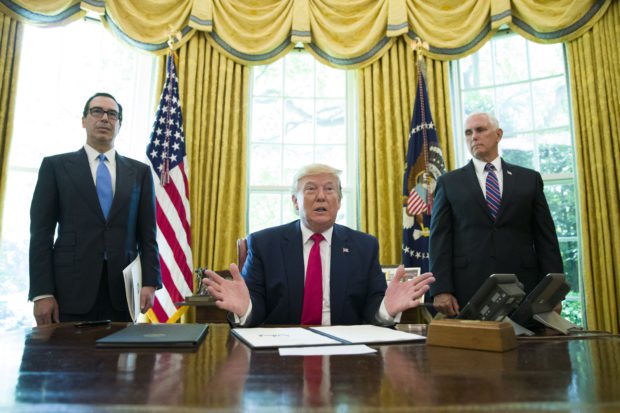WASHINGTON – President Donald Trump signed an executive order on Monday targeting Iran’s supreme leader and his associates with financial sanctions, the latest action the U.S. has taken to discourage Tehran from developing nuclear weapons and supporting militant groups.

President Donald Trump listens to a reporter’s question after signing an executive order to increase sanctions on Iran, in the Oval Office of the White House, Monday, June 24, 2019, in Washington. Trump is accompanied by Treasury Secretary Steve Mnuchin, left, and Vice President Mike Pence. (AP Photo/Alex Brandon)
The sanctions follow Iran’s downing of a more than $100 million U.S. surveillance drone over the Strait of Hormuz. Trump pulled back from the brink of retaliatory military strikes on Iran last week but is continuing his pressure campaign against the nation.
“These measures represent a strong and proportionate response to Iran’s increasingly provocative actions,” Trump told reporters in the Oval Office.
“We will continue to increase pressure on Tehran until the regime abandons its dangerous activities and its aspirations, including the pursuit of nuclear weapons, increased enrichment of uranium, development of ballistic missiles, engagement and support for terrorism, fueling of foreign conflicts and belligerent acts directed against the United States and its allies.”
Trump pulled the U.S. out of the nuclear pact that world powers made with Tehran in 2015. Other nations stayed in the deal, which eased sanctions on Iran in exchange for curbing its nuclear program.
Trump called it a one-sided deal in Iran’s favor and reimposed sanctions but says he wants to negotiate a different deal. Iran, which calls the sanctions “economic terrorism,” has shown no interest in negotiating.
Iran’s U.N. ambassador Majid Takht Ravanchi said U.S.-Iran talks are impossible under current conditions, adding, “You cannot start a dialogue with someone who is threatening, who is intimidating you.”
Ravanchi, who spoke with reporters while the U.N. Security Council held closed consultations on the rising tensions between the U.S. and Iran, said Washington should stop its military activity in the region, withdraw its naval forces and end what he called “economic warfare” against the Iranian people.
The latest round of sanctions denies Supreme Leader Ali Khamenei and senior military figures access to financial resources and blocks their access to any financial assets they have under U.S. jurisdiction.
“For people who say these are just symbolic, that’s not the case at all,” Treasury Secretary Steven Mnuchin said. “We’ve literally locked up tens and tens of billions of dollars.”
Trump said the new sanctions are not only in response to the downing of the drone. The U.S. has blamed Iran for attacks on two oil tankers this month near the Strait of Hormuz.
Citing those episodes and intelligence about other Iranian threats, the U.S. has sent an aircraft carrier to the Persian Gulf region and deployed additional troops alongside the tens of thousands already there.
All this has raised fears that a miscalculation or further rise in tensions could push the U.S. and Iran into an open conflict 40 years after Tehran’s Islamic Revolution.
“The supreme leader of Iran is the one who is ultimately responsible for the hostile conduct of the regime,” Trump said. “He is respected within his country. He also oversees the regime’s most brutal instrument including the Islamic Revolutionary Guard.”
Iran’s naval commander has warned that Iranian forces would not hesitate to act again and shoot down more U.S. surveillance drones that violate Iranian airspace. The U.S. said the drone was flying over international waters.
“We confidently say that the crushing response can always be repeated, and the enemy knows it,” Rear Adm. Hossein Khanzadi Khanzadi was quoted as saying by the semi-official Tasnim news agency.
The sanctions came as Secretary of State Mike Pompeo is holding talks in the Middle East with officials in the United Arab Emirates and Saudi Arabia about countering the military threat from Iran by building a broad, global coalition that includes Asian and European countries.
Pompeo is likely to face a tough sell in Europe and Asia, particularly from those nations still committed to the 2015 nuclear deal. /gsg

